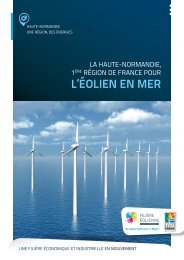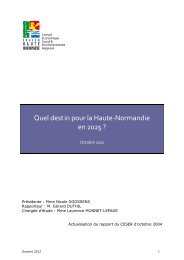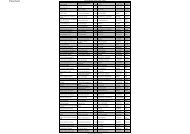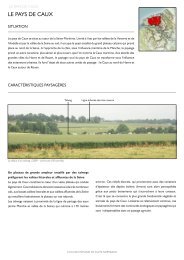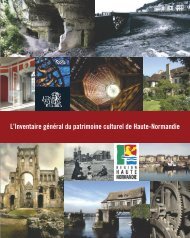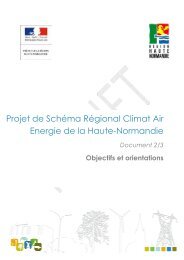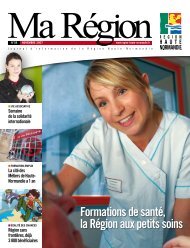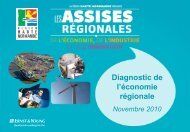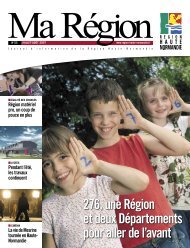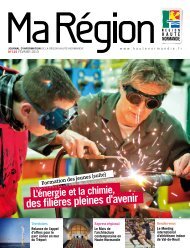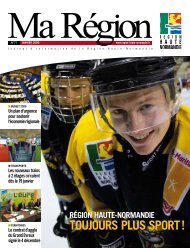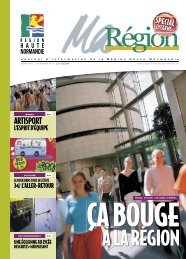Plan régional de la qualité de l'air en Normandie 2010 - 2015 (.pdf)
Plan régional de la qualité de l'air en Normandie 2010 - 2015 (.pdf)
Plan régional de la qualité de l'air en Normandie 2010 - 2015 (.pdf)
Create successful ePaper yourself
Turn your PDF publications into a flip-book with our unique Google optimized e-Paper software.
56<br />
PRQA EN NORMANDIE<br />
I. Les outils d’évaluation<br />
Les outils d’évaluation permett<strong>en</strong>t <strong>de</strong> mesurer l’état actuel <strong>de</strong> <strong>la</strong> <strong>qualité</strong> <strong>de</strong> l’air et <strong>de</strong> prévoir les<br />
impacts <strong>de</strong>s mesures et projets <strong>en</strong>visagés.<br />
I.1. Surveil<strong>la</strong>nce <strong>de</strong> <strong>la</strong> <strong>qualité</strong> <strong>de</strong> l’air<br />
I.1.1. Comm<strong>en</strong>t est mise <strong>en</strong> oeuvre <strong>la</strong> surveil<strong>la</strong>nce <strong>de</strong> <strong>la</strong> <strong>qualité</strong> <strong>de</strong> l’air ?<br />
En France, <strong>la</strong> surveil<strong>la</strong>nce <strong>de</strong> <strong>la</strong> <strong>qualité</strong> <strong>de</strong> l’air est mise <strong>en</strong> oeuvre par <strong>de</strong>s organismes agréés<br />
(AASQA) couvrant l'<strong>en</strong>semble du territoire, regroupées au niveau national au sein <strong>de</strong> <strong>la</strong> Fédération<br />
ATMO.<br />
Chaque AASQA est administrée par un Conseil d'Administration formé par quatre collèges<br />
équitablem<strong>en</strong>t représ<strong>en</strong>tés :<br />
o Les collectivités territoriales,<br />
o Les représ<strong>en</strong>tants <strong>de</strong>s activités contribuant à l'émission <strong>de</strong> substances surveillées,<br />
o Les associations agréées <strong>de</strong> protection <strong>de</strong> l'<strong>en</strong>vironnem<strong>en</strong>t, <strong>de</strong> déf<strong>en</strong>se <strong>de</strong>s<br />
consommateurs et <strong>de</strong>s personnalités qualifiées,<br />
o Les représ<strong>en</strong>tants <strong>de</strong> l'État et <strong>de</strong> ses établissem<strong>en</strong>ts publics.<br />
Les missions <strong>de</strong> base <strong>de</strong>s AASQA, selon <strong>la</strong> loi LAURE, sont les suivantes :<br />
o Mise <strong>en</strong> oeuvre <strong>de</strong> <strong>la</strong> surveil<strong>la</strong>nce et <strong>de</strong> l'information sur <strong>la</strong> <strong>qualité</strong> <strong>de</strong> <strong>l'air</strong>,<br />
o Diffusion <strong>de</strong>s résultats et <strong>de</strong>s prévisions,<br />
o Transmission immédiate aux Préfets <strong>de</strong>s informations re<strong>la</strong>tives aux dépassem<strong>en</strong>ts ou<br />
prévisions <strong>de</strong> dépassem<strong>en</strong>ts <strong>de</strong>s seuils d'alerte et <strong>de</strong> recommandations.<br />
Les régions Basse et Haute-<strong>Normandie</strong> compt<strong>en</strong>t <strong>de</strong>ux associations agréées pour <strong>la</strong> surveil<strong>la</strong>nce <strong>de</strong> <strong>la</strong><br />
<strong>qualité</strong> <strong>de</strong> l’air :<br />
o Air C.O.M. : pour <strong>la</strong> région Basse-<strong>Normandie</strong>.<br />
o Air Normand : pour <strong>la</strong> région Haute-<strong>Normandie</strong> et les cantons <strong>de</strong> Honfleur et Trouvillesur-Mer.<br />
I.1.2. Dispositif actuellem<strong>en</strong>t déployé dans les <strong>de</strong>ux régions<br />
Les AASQA mesur<strong>en</strong>t les conc<strong>en</strong>trations d’un nombre limité <strong>de</strong> polluants dans l’air ambiant. Ceux-ci<br />
doiv<strong>en</strong>t respecter certains critères comme être représ<strong>en</strong>tatifs d’un type <strong>de</strong> pollution et donc être<br />
« traceurs » <strong>de</strong> cette pollution (par exemple le dioxy<strong>de</strong> d’azote est un polluant traceur du trafic routier).<br />
Pour chacun <strong>de</strong>s polluants à mesurer, les AASQA choisiss<strong>en</strong>t <strong>de</strong>s techniques <strong>de</strong> mesure selon les<br />
recommandations établies au niveau europé<strong>en</strong>. Le mo<strong>de</strong> opératoire ainsi défini est <strong>en</strong>suite validé <strong>en</strong><br />
France par le Laboratoire C<strong>en</strong>tral <strong>de</strong> Surveil<strong>la</strong>nce <strong>de</strong> <strong>la</strong> Qualité <strong>de</strong> l’Air (LCSQA).<br />
Le dispositif <strong>de</strong> surveil<strong>la</strong>nce repose sur trois niveaux d’observation :<br />
o Un niveau urbain et périurbain, avec pour objectif d’informer sur <strong>la</strong> pollution <strong>de</strong> fond à l’échelle<br />
d’une agglomération et <strong>de</strong> sa périphérie ;<br />
o Un niveau <strong>de</strong> proximité, pour informer <strong>la</strong> <strong>qualité</strong> <strong>de</strong> l’air près <strong>de</strong>s sources directes <strong>de</strong> pollution<br />
(trafic automobile, industrie), <strong>en</strong> zone urbaine ou rurale ;<br />
Partie 1 : Inv<strong>en</strong>taire et Enjeux<br />
Outils <strong>de</strong> gestion <strong>de</strong> <strong>la</strong> pollution atmosphérique



